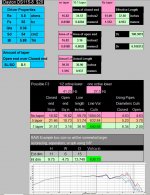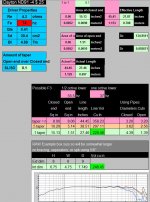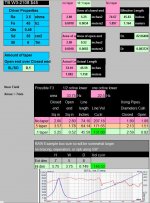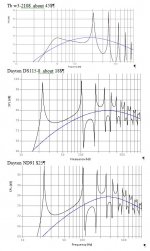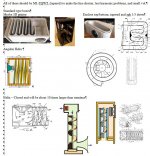… (ML-Tqwt)...
Note that ML-TQWT = mass loaded tapered quarter wave tube is, with less chance for confusion, and ML-Voigt, where the terminus end is larger than the closed end and there need to be lomger than a straight pipe or one the narrows towards the terminus for the same tuning.
dave
To Planet10,
Thanks for all your responses. I have an idea of building an adjustable transmission line that will allow for fast changing of the line length, the volume, the taper and the drivers so different variations can be tested. I don't want to post it if you don't think it is feasible. Is there a way I can send it to you?
thanks
scott
Send me an email.
dave
Thanks Planet10 for the advice. I now realize that the volume needs to be there as well as the length. I understand that the SD is not the main determination of the CSA but the Vas and/or Qts is. Does anyone know the formula to use to figure the CSA at the top of the closed chamber using either the Vas and/or Qts?
I have people telling me that a tapered T-line can't be as small as I'm thinking but here are the numbers that Alignment_Tables_Calculator_3_3_09.xls gives me for these three drivers. I understand that this spreadsheet has numbers close to MJK's numbers but maybe not? So I must be missing something because it sure looks like a near field 40hz in a small box is possible. Could someone check these numbers? Thanks
scott
I have people telling me that a tapered T-line can't be as small as I'm thinking but here are the numbers that Alignment_Tables_Calculator_3_3_09.xls gives me for these three drivers. I understand that this spreadsheet has numbers close to MJK's numbers but maybe not? So I must be missing something because it sure looks like a near field 40hz in a small box is possible. Could someone check these numbers? Thanks
scott
Attachments
But with a 3 or 4” you are unlikely to hit 40 Hz.
dave
Can't see why not.
My noisePlank is 54.5 x 14 x 4 cm internally (3 litres), so it probably counts as a low volume TL. It uses a 3.5" TG9FD10 driver and makes about 45Hz with just 6dB of eq. My line tapers from 45cm^2 at the driver end to 9cm^2 at the open end, with a single fold and ~1m length.
Right, if you're willing to trade enough efficiency away for extended BW, a tweeter can be EQ'd to do 20-20 kHz very quietly. 😉
GM
GM
Yep, that is called a "Headphone" or even smaller, a "ear bud."
I wonder suzj if your T-line was a tapered one, if it could be made smaller and hit the same 45Hz with another 3db?
I'm having a hard time trying to get 3 or 4 experts to form a group and collaborate on building the smallest ML-Tqwt that will have an F3 of 40hz. I was hoping that I would get some comments on those three example pictures in post 46 which seem to indicate that a very small T-line is possible. If someone is interested in joining me to develop this project, please sign up and let's begin the discussion before building one together.
scott
I wonder suzj if your T-line was a tapered one, if it could be made smaller and hit the same 45Hz with another 3db?
I'm having a hard time trying to get 3 or 4 experts to form a group and collaborate on building the smallest ML-Tqwt that will have an F3 of 40hz. I was hoping that I would get some comments on those three example pictures in post 46 which seem to indicate that a very small T-line is possible. If someone is interested in joining me to develop this project, please sign up and let's begin the discussion before building one together.
scott
AFAIK, we've already exposed you to all the necessary tech knowhow to do what you want, just set the minimum peak SPL you can tolerate [Pmax], then pick a driver that physically fits the desired size with the lowest [Fs] and meets the [Pmax] once EQ'd to a 40 Hz F3 and it is what it is.
Noting the obvious, B0$3 has been refining these alignments for many decades now, so comparing patents to actual products shows that when all is said and done all one can do is fool the person re 'perceived' bass, dynamic headroom response since you can't fool Mother Nature.
Have fun! BTW, seen this? http://www.diyaudio.com/forums/multi-way/309084-horns-inside-tv.html#post5109542
Patents:
https://www.google.com/patents/US6771787
https://www.google.com/patents/US8615097
GM
Noting the obvious, B0$3 has been refining these alignments for many decades now, so comparing patents to actual products shows that when all is said and done all one can do is fool the person re 'perceived' bass, dynamic headroom response since you can't fool Mother Nature.
Have fun! BTW, seen this? http://www.diyaudio.com/forums/multi-way/309084-horns-inside-tv.html#post5109542
Patents:
https://www.google.com/patents/US6771787
https://www.google.com/patents/US8615097
GM
Hey Dave,
could you look at the pictures in post 33 and give us your take on them. It seems that those drivers might get to around the 40 without EQ in the Line Volume mentioned (not box vol since those dimensions need the interior panels, speaker and outside panels. Thanks
scott
could you look at the pictures in post 33 and give us your take on them. It seems that those drivers might get to around the 40 without EQ in the Line Volume mentioned (not box vol since those dimensions need the interior panels, speaker and outside panels. Thanks
scott
A link in post 33, no pictures.
Put the driver into the modeler you have loaded up and see.
dave
Put the driver into the modeler you have loaded up and see.
dave
You need look no further than a trombone to see that it's possible to get very high SPL from small diameter tubes. I think the math behind line length for transmission lines is reasonable, but that for cross sectional area is much fuzzier.
It's all in the bell mouth which helps to match acoustic impedance in small tube to ambient air. A skinny TL will have resonances that sound like a "honk" or brassy trombone sound.
You need look no further than a trombone to see that it's possible to get very high SPL from small diameter tubes. I think the math behind line length for transmission lines is reasonable, but that for cross sectional area is much fuzzier.
But not in the LF unless it expands over a sufficiently long distance to a terminus [mouth] large enough to support the lowest frequency............
Not really as it's the net volume that sets the cab's low corner frequency, so once the terminus, upper corner frequency [based on driver specs], pathlength/taper is determined, the CSA is easily calculated.
GM
Hey Dave, Gm, Xrk91, and any other T-Line expert.
Here are the graphs below that seem to indicate that it is possible to make a very small T-line, near field, with an F3 at 40Hz (see post 46 for the size of the "line") and that is using, what I believe are inefficient enclosures compared to the ones picture below. Which one of those has the best chance as well as easy to build?
So I think I have done the work to, at least, look further into this but I can't seem to get people willing to join a group to collaborate, discuss a design, build it along with me so I can make a guide and post the results to this forum.
If the pictures below don't motivate anyone with, what it seems, like interesting, different and innovated T-lines, then there is no reason for me to continue to try to motivate people. If someone else wants to take up this thread and see if they can do better, I'll jump back in.
Thanks for all the posts up to now,
scott
Here are the graphs below that seem to indicate that it is possible to make a very small T-line, near field, with an F3 at 40Hz (see post 46 for the size of the "line") and that is using, what I believe are inefficient enclosures compared to the ones picture below. Which one of those has the best chance as well as easy to build?
So I think I have done the work to, at least, look further into this but I can't seem to get people willing to join a group to collaborate, discuss a design, build it along with me so I can make a guide and post the results to this forum.
If the pictures below don't motivate anyone with, what it seems, like interesting, different and innovated T-lines, then there is no reason for me to continue to try to motivate people. If someone else wants to take up this thread and see if they can do better, I'll jump back in.
Thanks for all the posts up to now,
scott
Attachments
There is nothing to innovate. You cannot fool the laws of physics, just operate within them. As Carl Sagan pointed out, the universe is not obliged to be in perfect harmony with human ambition.
-Acoustical length determines tuning Fb (Fp).
-Net bulk defines the lower corner frequency[ies].
-Line profile defines the usable (within in most cases rather narrow limits) gain BW.
-Driver and terminus tap locations where relevant help adjust the quantity of passband ripple by reducing excitation of harmonic modes.
-Damping also assists with attenuating undesired harmonic resonances, and where relevant, flattening the impedance if that happens to be a design goal (as in a purist TL).
That really is about 'it', on a macro level. You can play around with other factors on a detail front, which can and do affect performance, but none of them to the best of my knowledge are 'new', 'innovative' or 'different', and have been well-known physical principles and aspects of acoustical, gas-flow and mechanical engineering for decades. Not trying to squash enthusiasm or sound negative here, just stating some basic facts.
-Acoustical length determines tuning Fb (Fp).
-Net bulk defines the lower corner frequency[ies].
-Line profile defines the usable (within in most cases rather narrow limits) gain BW.
-Driver and terminus tap locations where relevant help adjust the quantity of passband ripple by reducing excitation of harmonic modes.
-Damping also assists with attenuating undesired harmonic resonances, and where relevant, flattening the impedance if that happens to be a design goal (as in a purist TL).
That really is about 'it', on a macro level. You can play around with other factors on a detail front, which can and do affect performance, but none of them to the best of my knowledge are 'new', 'innovative' or 'different', and have been well-known physical principles and aspects of acoustical, gas-flow and mechanical engineering for decades. Not trying to squash enthusiasm or sound negative here, just stating some basic facts.
Last edited:
- Status
- Not open for further replies.
- Home
- Loudspeakers
- Full Range
- Calling all T-Line experts – Designing a 40 Hz compact enclosure
